December 11, 2014
Montgomery Botanist Discovers Four New Palm Species
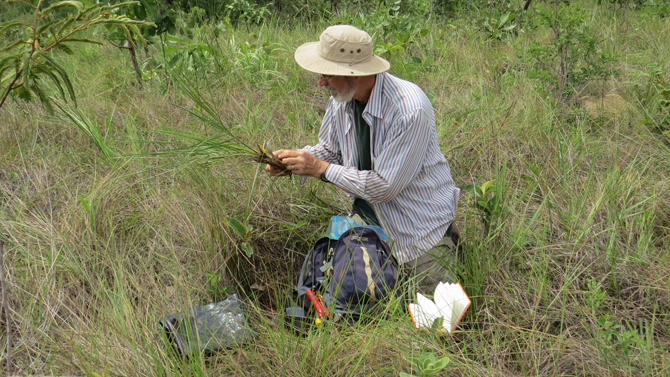
Four palm species are new to science! Larry Noblick, MBC Palm Biologist, along with his colleagues Harri Lorenzi and Vinicius Souza, present their findings in a recent issue of Phytotaxa. 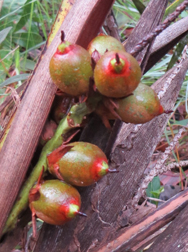
Very long drives over remote unpaved roads took these botanists to remote sites in Brazil, in cerrado (tropical savanna) habitats. There, the botanical team found four new species of Syagrus that very closely resemble grasses unless closely examined. Due to the native grassland habitat of these palms, these interesting palms have gone undetected until now.
The team chose to honor Jill Menzel with the species Syagrus menzeliana. A Director of the International Palm Society, Jill is a great supporter of palm horticulture, science and conservation. Syagrus menzeliana is a beautiful palm with pale blue-green foliage, with the unique feature of a prominent red ring on the fruits. Larry states: “This attractive palm with a pale bluish waxy bloom on the underside of its leaves will make a nice addition to any garden.”
Patrick Griffith, MBC Executive Director, adds: “I am excited to see that there are still so many great botanical discoveries to be made! Who would have known that such a unique palm was not yet described? I am also thrilled to see these experts come together in an international research effort – truly an inspiring collaboration!”
November 2014
Fall/Winter 2014 Montgomery Botanical News is Now Online!
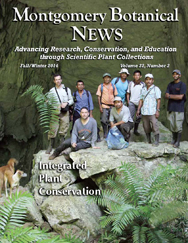 This new issue focuses on the Sinkhole Cycad Project. A collaborative project which brought together experts from MBC, The USDA Chapman Field, Botanic Gardens Conservation International, Belize Botanic Gardens, Ya'axche Conservation Trust, and Teakettle Enterprises. This project was made possible in part by the Institute of Museum and Library Services [MA-05-12-0336-12], the SOS - Save Our Species Fund, and The Mohamed bin Zayed Species Conservation Fund, as well as by staff time provided by participating organizations.
This new issue focuses on the Sinkhole Cycad Project. A collaborative project which brought together experts from MBC, The USDA Chapman Field, Botanic Gardens Conservation International, Belize Botanic Gardens, Ya'axche Conservation Trust, and Teakettle Enterprises. This project was made possible in part by the Institute of Museum and Library Services [MA-05-12-0336-12], the SOS - Save Our Species Fund, and The Mohamed bin Zayed Species Conservation Fund, as well as by staff time provided by participating organizations.
Please see pages 6 and 7 for an article on the International Palm Society's 2014 biennial visit. Over 125 palm enthusiasts from around the world visted Montgomery for a special lunch and tour!
This year, Montgomery Botanical Center was awarded the highest level of accreditation, Level IV, from The ArbNet Arboretum Accreditation Program, and Montgomery was named Community Partner of the Year by Miami Dade College's Institute for Civic Engagement and Democracy (see page 6).
Your support is greatly appreciated and helps Montgomery meet its mission year after year. If you would like to support Montgomery online please visit our Support Us page.
Montgomery Botanical Center publishes two newsletters a year to keep our supporters and collaborators up to date and informed.
To read more about how Montgomery Botanical Center meets our mission of "Advancing Research, Conservation, and Education through Scientific Plant Collections" please see our newsletters online.
November 2014
Montgomery Exchanges Conifers with Royal Botanic Garden Edinburgh
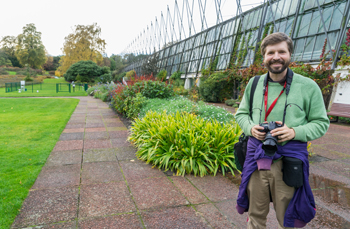 Conifers are the second most threatened major group of plants after cycads: 34% of species are threatened with extinction. Ex situ conservation efforts are an important part of comprehensive conservation strategies for these ancient plants. For the past eight years, MBC has been actively expanding its tropical conifer collection. As part of this effort, from October 17 to November 4, Dr. Chad Husby exchanged tropical conifer propagules with botanical gardens in the United Kingdom, Germany and the Czech Republic. The trip was sponsored by a Jean Iseli Memorial Grant of the American Conifer Society and is part of ongoing collaborations with the Atlanta Botanical Garden (ABG) to expand and improve tropical conifer conservation collections in the US.
Conifers are the second most threatened major group of plants after cycads: 34% of species are threatened with extinction. Ex situ conservation efforts are an important part of comprehensive conservation strategies for these ancient plants. For the past eight years, MBC has been actively expanding its tropical conifer collection. As part of this effort, from October 17 to November 4, Dr. Chad Husby exchanged tropical conifer propagules with botanical gardens in the United Kingdom, Germany and the Czech Republic. The trip was sponsored by a Jean Iseli Memorial Grant of the American Conifer Society and is part of ongoing collaborations with the Atlanta Botanical Garden (ABG) to expand and improve tropical conifer conservation collections in the US.
The trip builds on longstanding collaborations between MBC and sister institutions in Europe: the International Conifer Conservation Programme (ICCP) of the Royal Botanic Garden Edinburgh (RBGE) (Edinburgh, UK), the Prague Botanical Garden (Prague, Czech Republic), Rombergpark Botanical Garden (Dortmund, Germany), Bedgebury National Pinetum and Forest (Goudhurst, UK), and the Botanical Garden of Ruhr University, Bochum (Germany).
Cuttings of many conifers were collected, totaling more than 60 accessions of almost all wild origin tropical conifers, mostly from the family Podocarpaceae. Among the many noteworthy collections are two new species of Podocarpus from the Solomon Islands collected by Martin Gardner and described by Dr. Robert Mill of the ICCP. Montgomery Botanical Center represents an important 'safe site' of the ICCP. Our tropical climate allows RBGE's tropical conifers to reach maturity (which is often not feasible in a glasshouse) so that their reproductive biology can be studied.
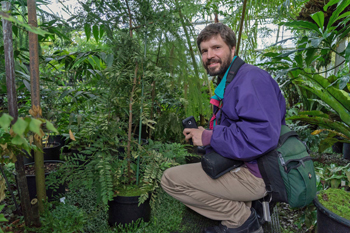 The expedition began in Dortmund, Germany, where longtime MBC collaborator, conifer expert Dr. Patrick Knopf, is now director of the Rombergpark Botanical Garden. Dr. Knopf hosted Chad and provided cuttings from his research and conservation collections. Chad also gave a public lecture on MBC's work at the Rombergpark Botanical Garden. Dr. Knopf and Chad also traveled to the Prague Botanical Garden to meet with Dr. Vlastik Rybka and Romana Rybková, who were recently hosted at MBC, to explore the gardens and collect conifer propagation material. Chad then departed for the United Kingdom where he spent a day with Daniel Luscombe, Assistant Curator of the Bedgebury National Pinetum and Forest, a key ICCP 'safe site' which has a very large conservation collection of temperate conifers. Afterwards, Chad spent a week at RBGE studying the tropical collections and collecting conifer propagation material with the help of Glasshouse & Quarantine Manager Fiona Inches and head horticulturist Andrew Ensoll. The propagation material arrived in good condition and propagation efforts are being shared between MBC and ABG, in emulation of successful conifer exchanges with RBGE in 2007 and 2008. This represents a significant enhancement of conifer collections at MBC and in North America and shows how much can be accomplished in a short time when botanical gardens work together in the interests of ex situ plant conservation.
The expedition began in Dortmund, Germany, where longtime MBC collaborator, conifer expert Dr. Patrick Knopf, is now director of the Rombergpark Botanical Garden. Dr. Knopf hosted Chad and provided cuttings from his research and conservation collections. Chad also gave a public lecture on MBC's work at the Rombergpark Botanical Garden. Dr. Knopf and Chad also traveled to the Prague Botanical Garden to meet with Dr. Vlastik Rybka and Romana Rybková, who were recently hosted at MBC, to explore the gardens and collect conifer propagation material. Chad then departed for the United Kingdom where he spent a day with Daniel Luscombe, Assistant Curator of the Bedgebury National Pinetum and Forest, a key ICCP 'safe site' which has a very large conservation collection of temperate conifers. Afterwards, Chad spent a week at RBGE studying the tropical collections and collecting conifer propagation material with the help of Glasshouse & Quarantine Manager Fiona Inches and head horticulturist Andrew Ensoll. The propagation material arrived in good condition and propagation efforts are being shared between MBC and ABG, in emulation of successful conifer exchanges with RBGE in 2007 and 2008. This represents a significant enhancement of conifer collections at MBC and in North America and shows how much can be accomplished in a short time when botanical gardens work together in the interests of ex situ plant conservation.
October 25 - October 26, 2014
Miami-Dade Chapter 2014 FNGLA Plant Market
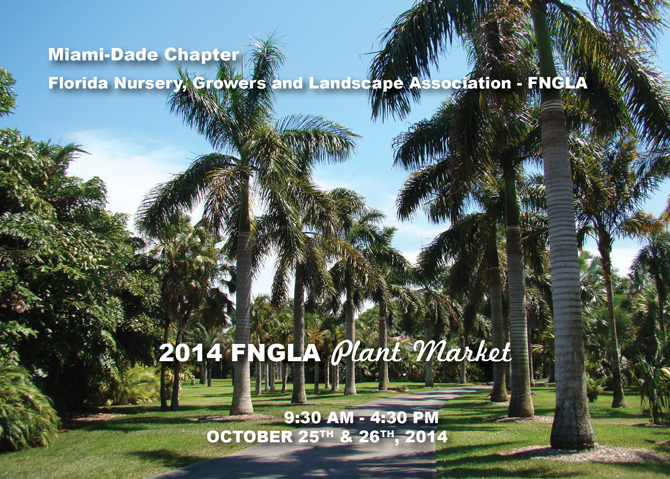
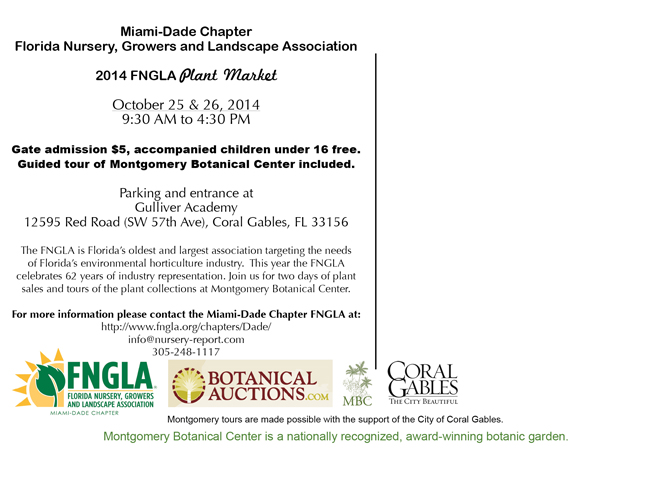
September 2014
Montgomery agreement with Gardens by the Bay, Singapore
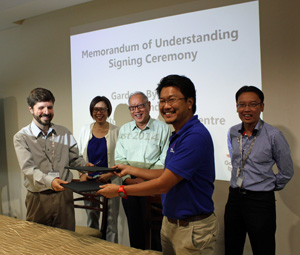 Montgomery is working very closely with colleagues in Singapore. From August 14-29, Chad Husby, at the invitation of Dr. Kiat Tan, Chief Executive Officer and Dr. Adrian Loo, Deputy Director of Research, was hosted by Gardens by the Bay (GB), a remarkable new botanic garden in Singapore. The purpose of the visit was to strengthen ties between our gardens through staff exchange to enhance horticulture, science and conservation efforts at both gardens. Chad presented a lecture at GB entitled: "Plant Exploration in the 21st Century: Where horticulture, conservation and botany come together". A Memorandum of Understanding (MOU) was signed to formalize our ongoing collaborations. Afterwards, Chad and Mr. John Tan of the GB Board of Directors, planted a Podocarpus costalis in the Discovery Garden along with a plaque to commemorate the agreement. Next year staff from GB plan to visit MBC to learn more about our garden and to foster collaborative work. MBC is honored to be part of the first agreement signed by GB and looks forward to a long and fruitful partnership.
Montgomery is working very closely with colleagues in Singapore. From August 14-29, Chad Husby, at the invitation of Dr. Kiat Tan, Chief Executive Officer and Dr. Adrian Loo, Deputy Director of Research, was hosted by Gardens by the Bay (GB), a remarkable new botanic garden in Singapore. The purpose of the visit was to strengthen ties between our gardens through staff exchange to enhance horticulture, science and conservation efforts at both gardens. Chad presented a lecture at GB entitled: "Plant Exploration in the 21st Century: Where horticulture, conservation and botany come together". A Memorandum of Understanding (MOU) was signed to formalize our ongoing collaborations. Afterwards, Chad and Mr. John Tan of the GB Board of Directors, planted a Podocarpus costalis in the Discovery Garden along with a plaque to commemorate the agreement. Next year staff from GB plan to visit MBC to learn more about our garden and to foster collaborative work. MBC is honored to be part of the first agreement signed by GB and looks forward to a long and fruitful partnership. 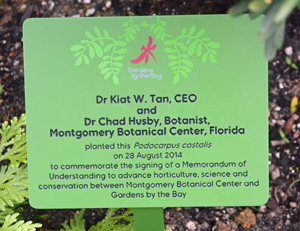
The visit overlapped with the 2014 Singapore Garden Festival, which drew large numbers of people to explore the wonders of horticulture at GB. Chad explored GB extensively got to know key staff, collections and operations at the garden. Learning about the operations of the garden's innovative and state-of-the-art conservatories (the Flower Dome and Cloud Forest Dome) was a special highlight.
Chad's visit also included exploration of key natural areas in Singapore, including Pulau Ubin (an island), where Chad and GB colleagues were guided by expert botanist Joseph Lai, and the Macritchie Central Catchment Nature Reserve. During these explorations Chad collected two new native Singaporean palm taxa for MBC's collections (Licuala ferruginea and Oncosperma horridum), new wild accessions of two other palms (Nypa fruticans and Caryota mitis), and the only conifer native to Singapore, Podocarpus polystachyus. Dr. Adrian Loo, Chad's primary host, is a the authority on native palms of Singapore, the primary author of "A Guide to the Native Palms of Singapore", and has recently rediscovered several palms thought to be extinct in Singapore. With Dr. Loo's help, we look forward to including more Singaporean native palms in our collections.
Our two gardens also exchanged many plants from our collections, which was coordinated by Anton van der Schans, Deputy Director of Plant Introduction and Health at GB. Chad also visited nurseries in Malaysia to learn more about horticulture in Asia.
The visit to GB was followed by a visit to Singapore Botanic Gardens (SBG), where Chad was hosted by Dr. Nura Abdul Karim, Assistant Director of Horticulture and Plant Records and Dr. Nigel Taylor, Director. Chad collected many tropical conifers at SBG to enhance MBC's conifer collection.
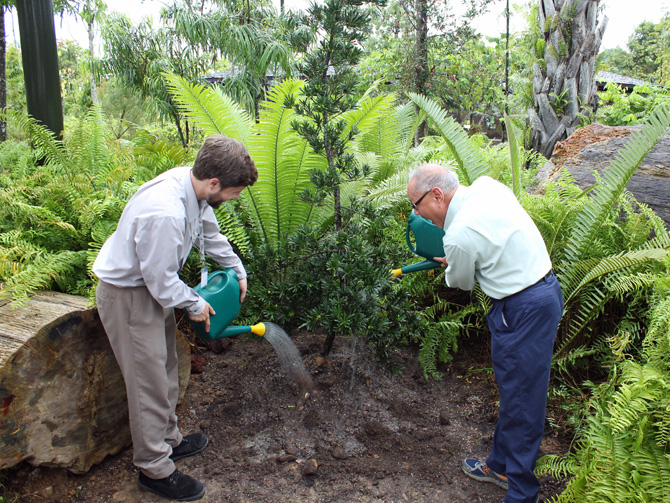
September 18, 2014
IMLS-Museums for America Grant Awarded to MBC
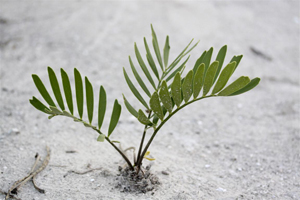 Montgomery Botanical Center just received an award to study Mission Based Collections Planning. This project was made possible in part by the Institute of Museum and Library Services [MA-30-14-0123-14]. The grant will fund research to develop a plan for managing MBC’s population-based living collection of Zamia lucayana, a group of cycads endemic to The Bahamas.
Montgomery Botanical Center just received an award to study Mission Based Collections Planning. This project was made possible in part by the Institute of Museum and Library Services [MA-30-14-0123-14]. The grant will fund research to develop a plan for managing MBC’s population-based living collection of Zamia lucayana, a group of cycads endemic to The Bahamas.
Montgomery will partner with the USDA Agricultural Research Service Subtropical Horticulture Research Station and Botanic Gardens Conservation International U.S. (BGCI U.S.) to conduct this research, which will directly improve the management of MBC’s Cycad Collection, and help other botanic garden conservation efforts.
The collaborative project team (USDA-SHRS, BGCI U.S., and MBC) will assess the genetic diversity of the botanic garden Zamia lucayana collection and compare the results with a prior IMLS funded project [MA-05-12-0336-12] on Zamia decumbens, while incorporating the new information into collections planning for future work devoted to cycad conservation. 
Project results will be publically shared with botanical gardens, plant researchers, research facilities, and the greater public through websites, tours, educational programming, conferences, reports, and scientific and popular publications.
For more on the IMLS find it on twitter @US_IMLS and www.facebook.com/USIMLS. Thank you IMLS!
August 26, 2014
New Paper Explores the Roots of Cycad Growth
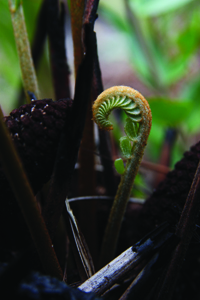 The MBC Team has some exciting news – Cycads share some important root features with much more “modern” flowering plants.
The MBC Team has some exciting news – Cycads share some important root features with much more “modern” flowering plants.
The new paper, appearing in the latest issue of the American Journal of Botany, demonstrates that cycads use the same method of root contraction – gelatinous fibers – as Gnetum, Ficus, and plants from other families. Especially in young plants, contracting roots can help protect the important growing tip, by holding it close to the soil level until it is large enough to withstand hazards. For example, the photo here shows a young Zamia from northern Florida recovering after a wildfire.
Although root contraction has been known in cycads, no one had yet demonstrated how this occurred. Through careful anatomical examination, Barry Tomlinson and his coauthors Tracy Magellan and Patrick Griffith saw that the collapsed soft tissues in cycad roots were not the cause of contraction, but rather the effect. Gelatinous contractile fibers exert the force needed to contract the young plants – just the same as on the roots of a Banyan Tree.
The finding here suggests that the adaptation of gelatinous fibers may be quite ancient – if these fibers appear in both cycads and flowering plants they may have originated in an era much older than previously thought.
"Working with Dr. Griffith and Dr. Tomlinson is great fun," said Tracy Magellan, corresponding author on the study. "Dr. Tomlinson is a brilliant anatomist with an eye for similarities and differences amongst many plant families. Having Dr. Tomlinson survey and study the diverse plant collections at Montgomery made this research possible." The authors now joke that they have shown that, “Cycas is like Ficus.”
The MBC team is very grateful to the Kelly Foundation, which funded this project through the Kelly Botanical Research Fellows Program.
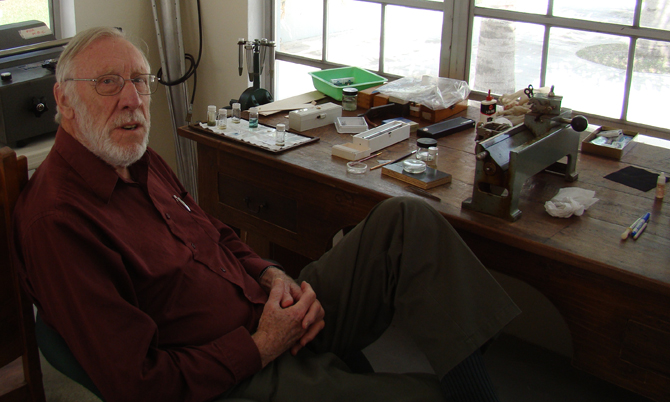
August 18, 2014
Montgomery's work featured on Community Projects World Map
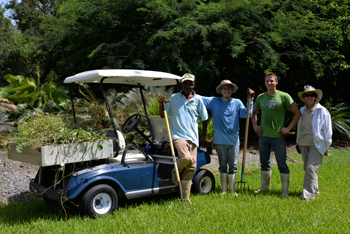 Botanic Gardens Conservation International (BGCI) has developed a new Community Projects World Map. Montgomery Botanical Center’s Conservation Horticulture Program and the Service Learning Program developed by Miami Dade College’s Institute for Civic Engagement and Democracy are highlighted. Montgomery Botanical Center is one of twelve gardens featured on the Community Projects World Map.
Botanic Gardens Conservation International (BGCI) has developed a new Community Projects World Map. Montgomery Botanical Center’s Conservation Horticulture Program and the Service Learning Program developed by Miami Dade College’s Institute for Civic Engagement and Democracy are highlighted. Montgomery Botanical Center is one of twelve gardens featured on the Community Projects World Map.
The Conservation Horticulture Fellowships were originally sponsored by the E. O. Dunn Foundation and now are also sponsored by The Batchelor Foundation, Inc. Students residing in Miami-Dade County, often attending Miami Dade College’s horticulture technology program, are selected for the fellowship. Students are taught conservation horticulture – managing living plants to prevent extinction – and the basics of caring for rare plants in the nursery. Conservation Horticulture Fellows gain insight into the field by rotating monthly between horticulture departments while learning to care for plants in the nursery and on the grounds. The photo above shows the 2014-2015 Conservation Horticulture Fellows working with the Cycad Curators.
The service-learning program, developed by Miami Dade College, fosters collaborations between students and local not-for-profit organizations as a component of their coursework. The service-learning program at Montgomery is an introduction to botanic gardens for many students. Though some students are biology and horticulture majors, the majority of students are first and second year students still deciding on majors. This program has the potential to influence young students into selecting STEM (Science, Technology, Engineering, and Mathematics) fields such as biology and botany as their majors, contributing to an increase in STEM majors in South Florida.
Montgomery Botanical Center is happy to partner with Miami Dade College in these programs, molding the next generation of conservation horticulturists and botanic garden workers. For more information on the programs at Montgomery Botanical Center, please see the webpage and select the “Community Projects” tab.
August 1, 2014
Conservation Expedition Featured in Cycad Journal
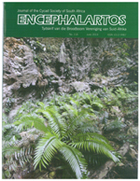 The recent cycad expedition in Southern Belize (see March 1, below) is featured on the cover of the latest issue of Encephalartos, Journal of the Cycad Society of South Africa. The article tells the story of the recent travels by Montgomery and Belize Botanic Gardens staff to study and collect the Sinkhole Cycad, Zamia decumbens.
The recent cycad expedition in Southern Belize (see March 1, below) is featured on the cover of the latest issue of Encephalartos, Journal of the Cycad Society of South Africa. The article tells the story of the recent travels by Montgomery and Belize Botanic Gardens staff to study and collect the Sinkhole Cycad, Zamia decumbens.
Encephalartos, the leading publication for cycads worldwide, is published by the Cycad Society of South Africa. As part of the Society’s aims to promote cultivation, networking, research and conservation of cycads, the magazine seeks to disseminate information in support of that mission. Encephalartos has been published since 1985, serving as a prime venue to communicate among cycad enthusiasts, horticulturists and scientists.
July 13, 2014
Rare Tropical Fruit Conference and Montgomery
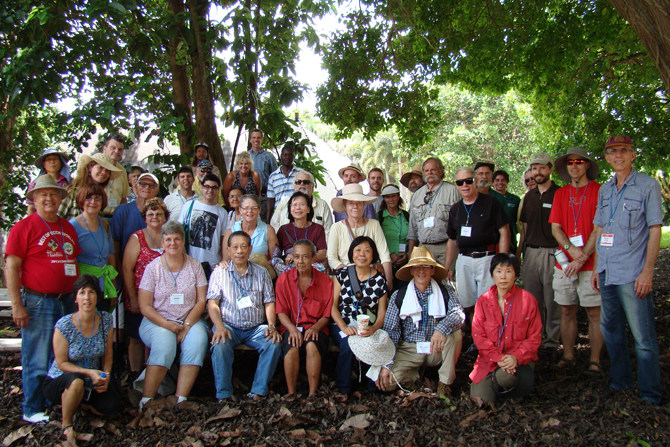
From July 9th-13th, the Tropical Fruit & Vegetable Society of the Redlands and the Fruit & Spice Park sponsored the 2014 Rare Tropical Fruit Conference. Montgomery Botanical Center was delighted to be involved in two portions of the conference. MBC was pleased to welcome 60 conference delegates on a tour on July 10. On July 13, Juanita Popenoe, from the MBC Board of Directors, gave a conference lecture titled, “Wilson Popenoe, The Original Indiana Jones."
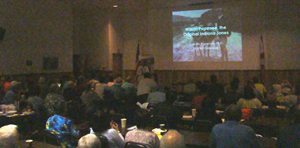 Dr. Juanita Popenoe is the University of Florida’s Lake County Extension Director and Commercial Ornamental Horticulture Agent III. She is the author of more than 72 publications and more than 15 professional presentations. She also comes from a family of botanists and horticulturists. Dr. John Popenoe, Juanita's father, was the longtime Director of Fairchild, served on the MBC Board of Directors, continues as the Botanical Consultant for Montgomery and has been involved with the organization for over 50 years. Juanita’s great uncle, Wilson Popenoe, lived many adventures while plant collecting and these adventures were the inspiration for the talk given by Juanita.
Dr. Juanita Popenoe is the University of Florida’s Lake County Extension Director and Commercial Ornamental Horticulture Agent III. She is the author of more than 72 publications and more than 15 professional presentations. She also comes from a family of botanists and horticulturists. Dr. John Popenoe, Juanita's father, was the longtime Director of Fairchild, served on the MBC Board of Directors, continues as the Botanical Consultant for Montgomery and has been involved with the organization for over 50 years. Juanita’s great uncle, Wilson Popenoe, lived many adventures while plant collecting and these adventures were the inspiration for the talk given by Juanita.
July 2014
Cycad Photosynthesis Project at Montgomery
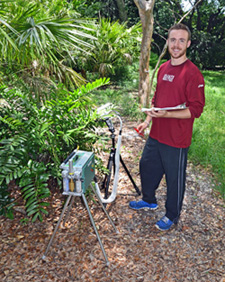 Christopher Krieg has been studying photosynthesis patterns in cycads at MBC during June and July. From morning to early afternoon he has been using a sophisticated instrument, the LiCor 6400 Photosynthesis System, to measure photosynthesis rates of cycad leaflets and has been using MBC’s microscope facility at the Chris Tyson Plant Conservation Building to measure stomatal density and leaf area.
Christopher Krieg has been studying photosynthesis patterns in cycads at MBC during June and July. From morning to early afternoon he has been using a sophisticated instrument, the LiCor 6400 Photosynthesis System, to measure photosynthesis rates of cycad leaflets and has been using MBC’s microscope facility at the Chris Tyson Plant Conservation Building to measure stomatal density and leaf area.
This research is being carried out under the direction of Dr. James E. Watkins of Colgate University in New York. The goal of this project is to evaluate ecophysiological costs associated with reproduction in cycads by comparing photosynthetic behavior of male and female plants. Furthermore, the study aims to elucidate differences and similarities photosynthetic characteristics across cycad species and genera. This study was inspired by previous research Christopher undertook on sunfleck utilization in ferns, cycads and angiosperms.
Christopher recently graduated from Colgate University with a B.A. in biology and plans to pursue graduate studies in plant physiology.
July 9, 2014
Seminar on the Royal Botanic Gardens, Sydney
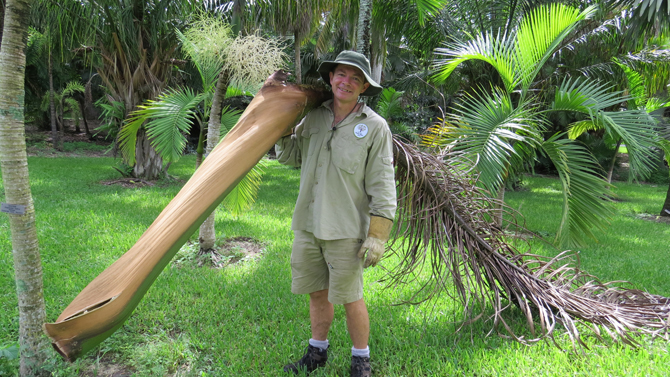
Title: The Royal Botanic Gardens, Sydney - The Palm Grove and other major displays and collections
Speaker: Paul Nicholson, Senior Horticulturist at the Royal Botanic Gardens, Sydney, Australia
Time: Wednesday, July 9, 2014 at 2:15 pm
Location: Nixon Smiley Meeting Room, Montgomery Botanical Center.
Description: Paul Nicholson, from the Royal Botanic Gardens, Sydney, will be giving a lecture about RBG, Sydney at Montgomery Botanical Center. Paul's lecture will highlight the palm grove in the garden and other major displays and collections. Brought to you with the support of the City of Coral Gables.
About the Speaker: Paul Nicholson, Senior Horticulturist, at the Royal Botanic Gardens, Sydney is gaining experience from working with our staff at Montgomery Botanical Center (MBC). He was awarded a scholarship to visit Montgomery and Fairchild this year to develop his skills in all areas of palm curation with particular emphasis on interpretation, propagation, seed collection and storage. He will work at MBC from July 2 to July 14.
June 20, 2014
Montgomery Awarded Highest Arboretum Accreditation
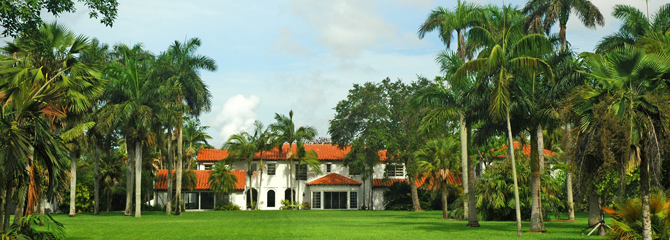
MBC was just recognized among the highest level of arboreta! Montgomery received a level IV accreditation, the highest of four levels, from ArbNet, the interactive community of arboreta.
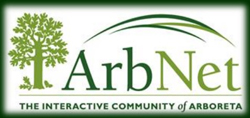 By achieving particular standards of professional practices deemed important for tree collections, Montgomery is now recognized as an accredited arboretum in The Morton Register of Arboreta. The ArbNet accreditation process examined MBC’s planning, governance, labeling of species, staff or volunteer support, public access and programming and tree science, planting and conservation efforts.
By achieving particular standards of professional practices deemed important for tree collections, Montgomery is now recognized as an accredited arboretum in The Morton Register of Arboreta. The ArbNet accreditation process examined MBC’s planning, governance, labeling of species, staff or volunteer support, public access and programming and tree science, planting and conservation efforts.
The ArbNet Arboretum Accreditation Program is sponsored and coordinated by The Morton Arboretum in cooperation with American Public Gardens Association and Botanic Gardens Conservation International.
"It is nice to see ArbNet bringing together arboreta from around the world to develop a tree-focused public garden community," said Tracy Magellan, MBC Outreach Manager. "I am looking forward to seeing collaborations built between gardens of similar sizes and foci through this program. Keep up the good work ArbNet!"
“I’ve always been proud of our great team at Montgomery;” stated Patrick Griffith, MBC Executive Director, “but I get to work with them every day! It is nice to know that our Team’s great work is now recognized by an international evaluation. This accolade is something that whole Montgomery Team – Board, Staff, Members and Volunteers – can share.”
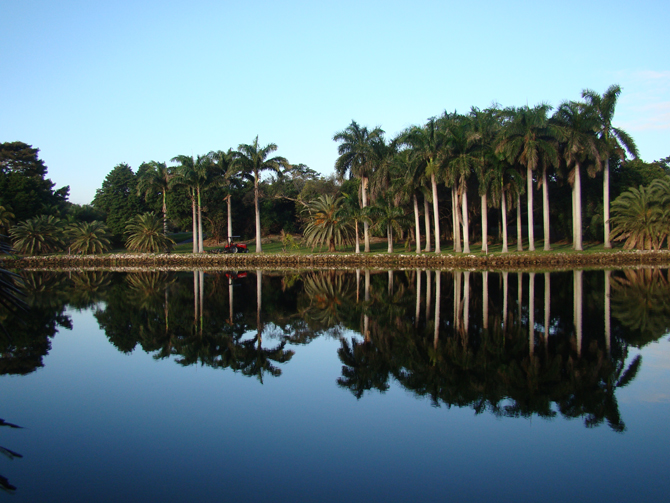
May 30, 2014
International Palm Society at Montgomery
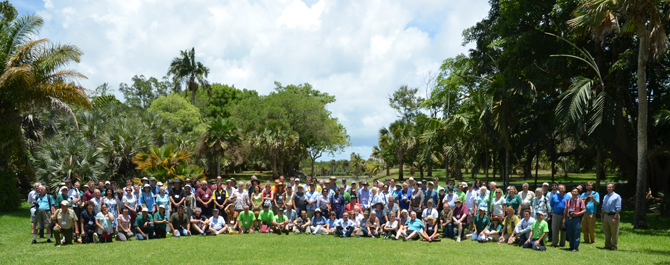
Over 120 palm enthusiasts from around the world came to Miami this week for the International Palm Society Biennial. Delegates from over 20 countries – and from every habitable continent – visited South Florida palm habitats and gardens. The final day of their visit included an outdoor lunch, live music and guided tours at Montgomery. 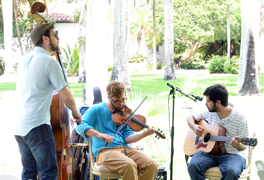
The MBC Team was delighted to welcome the group, and spent a great afternoon sharing the palm collection, landscapes, and seeds with the delegation. This was a rare opportunity to showcase Montgomery’s palm collection to a very enthusiastic, worldwide group of experts!
The International Palm Society (IPS) works to promote scientific and educational purposes for palms related to propagation, culture, conservation, care, and development. In addition to publishing the wonderful journal Palms, the IPS is a leading supporter of palm research and conservation projects through their Endowment Fund Grants. These grants have helped projects at MBC, including palm genetics research, and palm collecting expeditions.
Montgomery is especially grateful to our sponsors Jill Menzel and Redland Nursery for generously funding this event.

May 23, 2014
Seminar on Cenozoic Cycad Evolution
Title: Chapters from the Cenozoic History of Cycads.
Speaker: Dr. Boglarka Erdei, Hungarian Museum of Natural History.
Time: Friday, May 23. 1:30 pm, Reception, coffee and cookies; 2:00 pm, lecture.
Location: Nixon Smiley Meeting Room, Montgomery Botanical Center.
Description: Dr. Erdei writes: "The fossil record gives clear evidence that cycads were flourishing during the Mesozoic. But what do we know about their evolution in the Cenozoic, the past 65 million years? In my presentation I would like to highlight some interesting aspects of early Tertiary cycad evolution."
About the Speaker: Dr. Erdei, a paleobotanist and expert on fossil cycads, has spent the last year at Montgomery Botanical Center as a Research Fellow, supported by the Hungarian American Enterprise Scholarship Fund. She has worked to compare MBC's living cycad collection to extinct species known only from fossils.
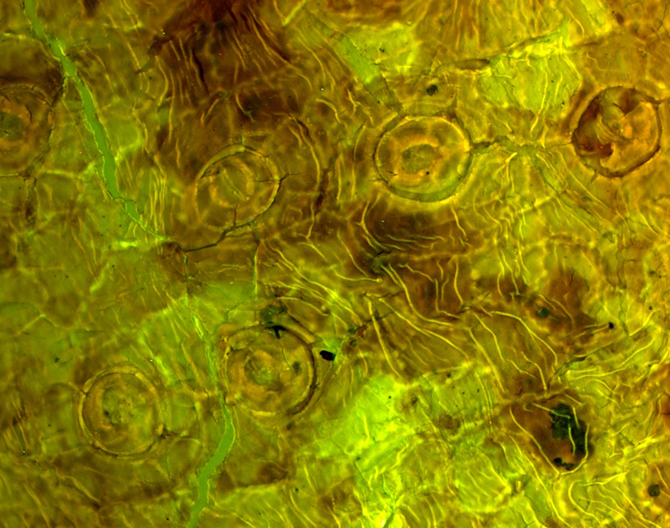
Lower cuticle of a 30 million year old cycad leaf from California
April 30, 2014
Miami Dade Honors Montgomery with Award
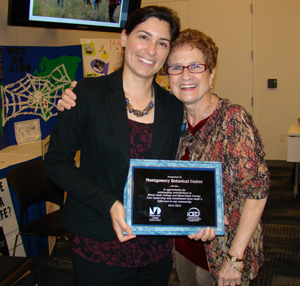 Montgomery Botanical Center was selected by Miami Dade College's Institute for Civic Engagement and Democracy (iCED) as its 2013-2014 Community Partner of the Year!
Montgomery Botanical Center was selected by Miami Dade College's Institute for Civic Engagement and Democracy (iCED) as its 2013-2014 Community Partner of the Year!
Montgomery has been involved with Miami Dade College's Service Learning Program since 2010. Ossie Hanauer, Director of Service Learning at Miami Dade College, and Theresa Pahl-Belitsky, Service Learning Coordinator at Kendall Campus, presented the award to Tracy Magellan, Outreach Manager at Montgomery Botanical Center (see photo of Tracy Magellan receiving the award in behalf of Montgomery Botanical Center from Ossie Hanauer).
Students have been using the concepts they learn at Miami Dade College in the nursery at Montgomery Botanical Center helping MBC care for its youngest plants.
In 2013, Montgomery Botanical Center's collaboration with Miami Dade College was highlighted in the "Engaging College Students in the World of Public Gardens" issue of Public Garden, the Journal of the American Public Gardens Association (APGA).
The Service Learning program has exposed young horticulturists to Montgomery Botanical Center and has given MBC the opportunity to train and develop a new generation of horticulturists.
The award states, "In appreciation for outstanding contributions to Miami Dade College and Miami-Dade County. Your leadership and commitment have made a difference in our community."
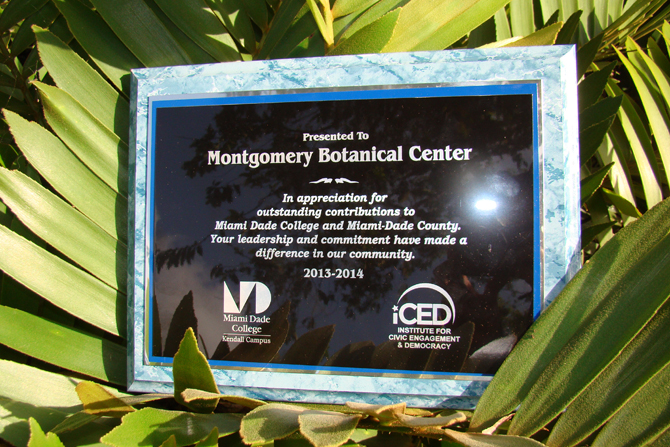
April 15, 2014
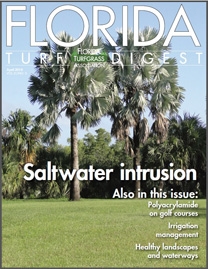 Cover Story Featuring Montgomery
Cover Story Featuring Montgomery
The current issue of Florida Turf Digest features MBC on the cover. The article, Saltwater Intrusion in the Biscayne Aquifer: a case study at the Montgomery Botanical Center, discusses the effects of regional water management history with an in-depth review of how this has been observed onsite.
The article by Lee Anderson, MBC Superintendent, highlights the challenges of managing freshwater irrigation for a garden, with diverse plant collections, supplied by the Biscayne Aquifer, which also supplies the thriving agriculture and metropolitan region of South Florida. The history of MBC wells and plantings in this context can illustrate how water resources can change over time, and how a botanic garden must adapt to these changes.
Florida Turf Digest is published by the Florida Turf Management Association, which is dedicated to environmentally-responsible, professional, and scientifically-based management practices for turfgrass.
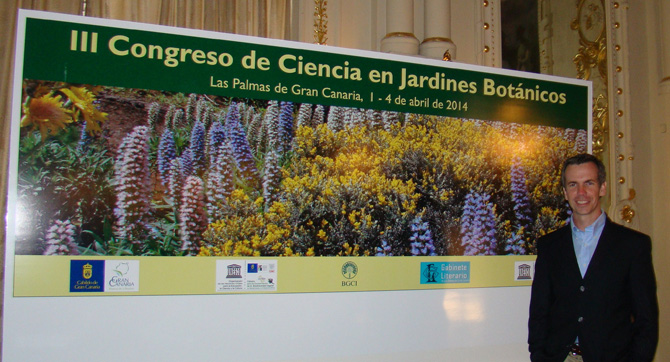
April 4, 2014
Montgomery’s work featured at Botanic Garden Science Congress
Montgomery Botanical Center’s work was featured at the 3rd Science in Botanic Gardens Congress (3SBGC). Patrick Griffith, Executive Director, was invited to present MBC’s work about the genetics of conservation collections.
Common themes on taxonomy, molecular biology and conservation science brought together scientists from many botanic gardens in Austria, Belgium, Ireland, Morocco, Poland, Russia, Spain, the United Kingdom, and The United States. The conference was sponsored by UNESCO, BGCI, and the Jardín Botánico Canario Viera y Clavijo, and convened in the historic Gabinete Literario in downtown Las Palmas de Gran Canaria.
Patrick’s talk, “Biology informs strategy: conservation genetics of botanic garden collections,” highlighted MBC’s studies on ex situ plant conservation, using model systems from the palm and cycad collections, and how these integrate with fieldwork (see March 1, 2014 article below) and in situ conservation activities. These projects have been generously funded by the IMLS, the IPS, SOS-Save Our Species, and MBZ.
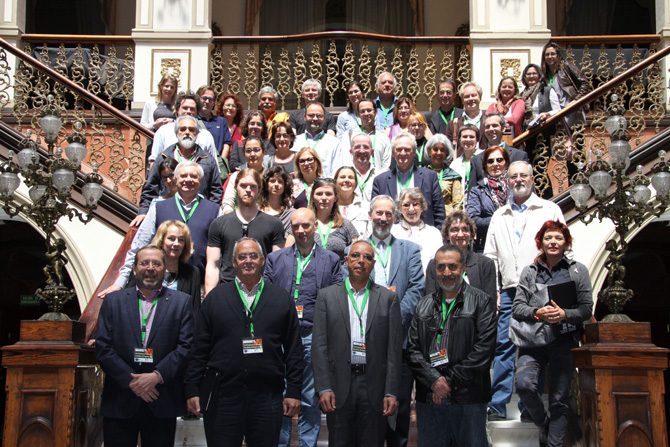
April 3, 2014
Montgomery Co-Sponsors the 26th Annual Gifford Arboretum Lecture at the University of Miami
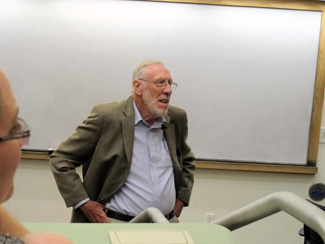 Dr. P. Barry Tomlinson, Professor Emeritus at Harvard University and Research Fellow at Montgomery Botanical Center gave the 26th Annual Gifford Arboretum Lecture at the University of Miami titled, "Longevity in Plant Cells - Are Palms the Longest-lived Trees?"
Dr. P. Barry Tomlinson, Professor Emeritus at Harvard University and Research Fellow at Montgomery Botanical Center gave the 26th Annual Gifford Arboretum Lecture at the University of Miami titled, "Longevity in Plant Cells - Are Palms the Longest-lived Trees?"
Dr. Barry Tomlinson has conducted ground breaking research on how palm cells significantly differ from those of conifers and hardwoods. Dr. Tomlinson’s article on this topic can be found in the American Journal of Botany.
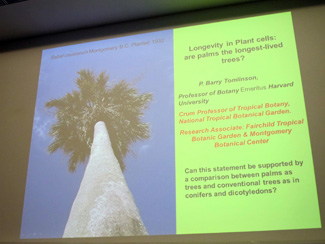 This lecture, co-sponsored by the Gifford Arboretum at the University of Miami and Montgomery Botanical Center, was well attended leaving standing room only. Colleagues from Florida International University, the Kampong, and other local gardens, schools, organizations, and individuals attended the informative lecture. A video showing cellular motion in the stem of Rhapis was thoroughly enjoyed by the crowd.
This lecture, co-sponsored by the Gifford Arboretum at the University of Miami and Montgomery Botanical Center, was well attended leaving standing room only. Colleagues from Florida International University, the Kampong, and other local gardens, schools, organizations, and individuals attended the informative lecture. A video showing cellular motion in the stem of Rhapis was thoroughly enjoyed by the crowd.
The Gifford Arboretum Lecture is part of the CETroB lecture series and was brought to you with the support of the City of Coral Gables and the Kelly Foundation.
April 2014
Spring/Summer 2014 Montgomery Botanical News is Now Online!
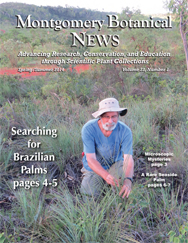 This new issue has articles on collecting Syagrus in Brazil, searching for Coccothrinax in the Dominican Republic, and the innovative science that our Research Fellows are conducting at MBC. There is also news on recent publications and awards received by MBC.
This new issue has articles on collecting Syagrus in Brazil, searching for Coccothrinax in the Dominican Republic, and the innovative science that our Research Fellows are conducting at MBC. There is also news on recent publications and awards received by MBC.
Please see pages 10 and 11 for a list of grants and support received in 2013. Your support is greatly appreciated and helps Montgomery meet its mission year after year. If you would like to support Montgomery online please visit our Support Us page.
Montgomery Botanical Center publishes two newsletters a year to keep our supporters and collaborators up to date and informed.
To read more about how Montgomery Botanical Center meets our mission of "Advancing Research, Conservation, and Education through Scientific Plant Collections" please see our newsletters online.
March 1, 2014
Cycad Expedition in Southern Belize
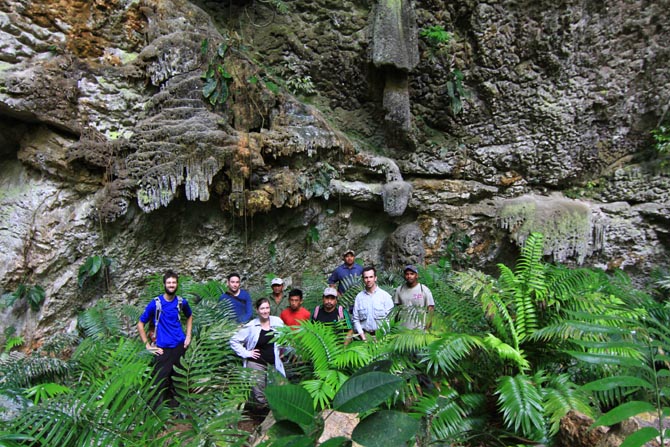
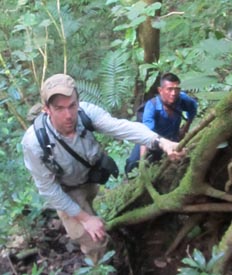 A major expedition to conserve a remote cycad! Montgomery Executive Director Patrick Griffith and Cycad Biologist Michael Calonje recently led a collaborative team – 18 people, 3 horses and 3 dogs – to distant caves in the Maya Mountains.
A major expedition to conserve a remote cycad! Montgomery Executive Director Patrick Griffith and Cycad Biologist Michael Calonje recently led a collaborative team – 18 people, 3 horses and 3 dogs – to distant caves in the Maya Mountains.
In addition to Montgomery, the team included botany, horticulture and wildlife experts from Belize Botanic Gardens, Teakettle Enterprises, and the Ya’axche Conservation Trust, in addition to local and national support personnel.
The species studied here – The Sinkhole Cycad, Zamia decumbens – has been of great recent interest. Michael and co-authors described this species only in 2009. Based on its biological and geographic circumstances, this cycad has the potential to inform conservation methods for other plants. Montgomery is developing a new model for botanic garden conservation collections based on this species.
The same geographic circumstances that make this cycad ideal for research and conservation – remote caves in the mountain forest – prompted careful logistics and planning. The study sites are a full day’s walk beyond roads, and quite near the Guatemalan border. Three nights of distant bivouac with food, camp gear and botanical tools – for such a large group – required a pack train of three horses. In addition, the increased presence of xateros (palm poachers) in the area made security planning necessary.
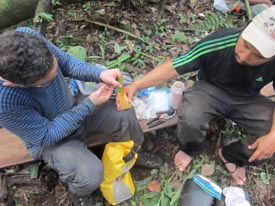 These major efforts were absolutely worth it: Michael and Patrick were delighted to learn of and document a third major population of this cycad in yet another remote site! The team took extensive notes, photographs, DNA samples and seeds for research and conservation. The new findings and collections will help conserve this rare cycad, as well as inform conservation for other plants species.
These major efforts were absolutely worth it: Michael and Patrick were delighted to learn of and document a third major population of this cycad in yet another remote site! The team took extensive notes, photographs, DNA samples and seeds for research and conservation. The new findings and collections will help conserve this rare cycad, as well as inform conservation for other plants species.
The field expedition was generously supported by grants from SOS Save Our Species, and the Mohamed bin Zayed Species Conservation Fund, in addition to the staff time provided by the participating organizations. duPlooy’s Jungle Lodge also very generously provided in-kind support of food and lodging for the project. We also are very grateful to the Belize Forest Department for permission to study and collect these plants.
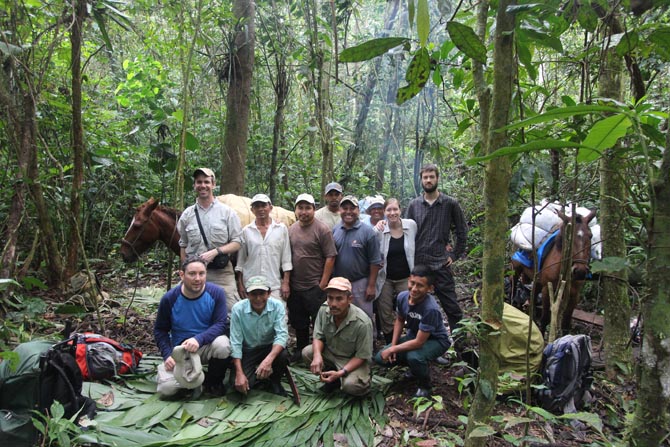
February 20, 2014
Montgomery Palm Expedition in Southern Brazil
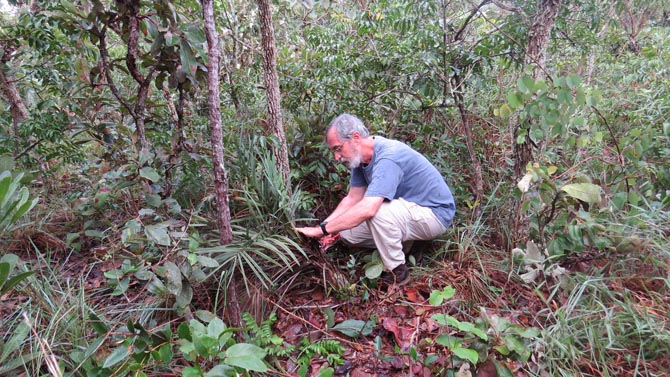
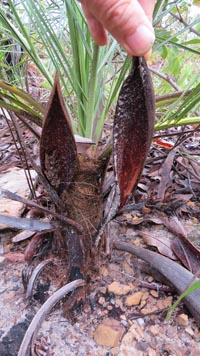 New discoveries, new confirmations and new collections – Larry Noblick, MBC Palm Biologist, has just returned from southern Brazil, where he has spent the last 7 weeks studying a group of fascinating “stemless” palms.
New discoveries, new confirmations and new collections – Larry Noblick, MBC Palm Biologist, has just returned from southern Brazil, where he has spent the last 7 weeks studying a group of fascinating “stemless” palms.
New findings have confirmed that the genus Syagrus is the closest living relative of the Coconut, one of the world’s most useful plants. In addition to the familiar Queen Palm, Syagrus includes many palm species which are quite diminutive and appear to grow as a clump of leaves with an underground, hidden stem. These species grow in savanna and rocky grassland habitats and can often be mistaken for grasses, due to their hidden stems and long thin leaflets. But their relationship to coconuts is often revealed by the fruit and seed of these little-known palms.
While afield, Larry was hosted by the Instituto Plantarum, Jardim Botanico Plantarum and Harri Lorenzi, his longtime collaborator and coauthor. The Jardim Botanico Plantarum’s lab facilities allowed Larry to make accurate identifications through microscopic examination.
The expedition covered a lot of ground – over 9,000 miles in 5 states – in search of these hidden gems. Through this intensive fieldwork, Larry recorded new locations for known species, and also discovered some new species. Seeds and herbarium specimens of these palms are now back at Montgomery and under further study.
The expedition was very generously supported by the Paul Drummond Fund for Palm Conservation.
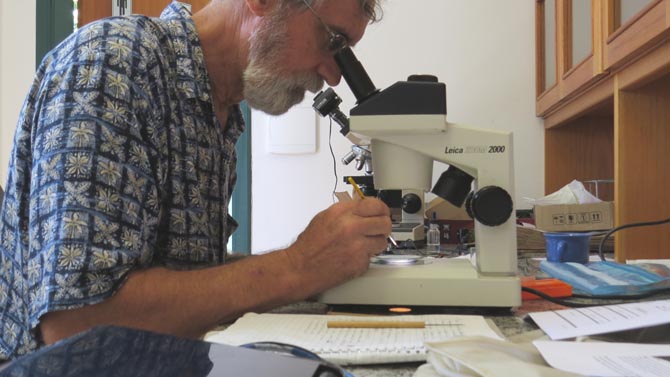
February 18, 2014
Montgomery Research at Fossil Conference
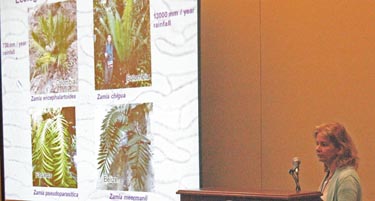 New findings link ancient fossils to modern plants! Dr. Boglarka Erdei, Research Fellow at Montgomery and Chief Museologist at the Hungarian Natural History Museum, discussed her findings at the 10th Conference of the North American Paleontological Convention in Gainesville this week.
New findings link ancient fossils to modern plants! Dr. Boglarka Erdei, Research Fellow at Montgomery and Chief Museologist at the Hungarian Natural History Museum, discussed her findings at the 10th Conference of the North American Paleontological Convention in Gainesville this week.
Dr. Erdei’s work, done in close collaboration with Michael Calonje, MBC Cycad Biologist, and Nicolas Espinosa, an NSF-supported undergraduate intern (FIU), compared an Eocene cycad fossil from Panama with the living plant collections at Montgomery, in order to determine its nearest modern relatives. Careful microscopic examination of the leaf surface, using digital measurements and statistical analysis, indicates that the fossil is a Zamia, with a close affinity to Zamia from the Caribbean.
This research has found shows a new way that the modern living cycads at Montgomery can help advance the understanding of ancient plants!
February 14, 2014
Lecture by Natalie Prior on Cycad Pollination Drops
Please join us for a special seminar at Montgomery Botanical Center.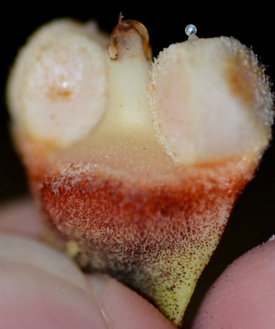
Title: "Proteomics of cycad pollination drops"
Speaker: Natalie Prior, University of Victoria, British Columbia, Canada.
Date & time: Friday, February 14, at 2:00 PM. (Reception with refreshments at 2:00 PM, talk from 2:30-3:15 PM.)
Location: Nixon Smiley Meeting Room, Montgomery Botanical Center, 11901 Old Cutler Road, Coral Gables, FL 33156
About the presentation: In non-flowering seed plants, the gymnosperms, there are no flowers, and pollen enters ovules directly. In cycads, a fluid is secreted from the ovule (the pollination drop) that captures and transports pollen into the ovule. Biochemical analyses have shown that pollination drops typically contain a mixture of mineral and organic components, suggesting drops may play a more dynamic role in pollen-ovule interactions. I will discuss the results of proteomic analyses on the pollination drops of three cycad species collected at the Montgomery Botanical Center (Zamia furfuracea, Ceratozamia hildae, Cycas rumphii).
Brought to you with the support of the City of Coral Gables.
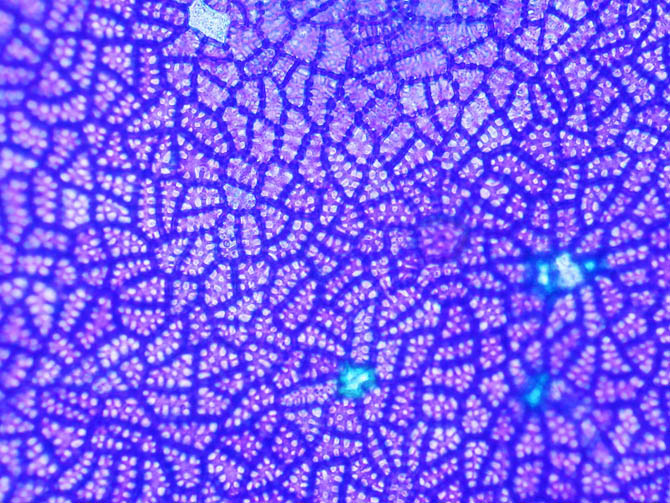
February 4, 2014
New Paper on Cycad Anatomy
The oldest cycads still show features of ancient plants – this is one idea put forward in the latest paper from the Montgomery Team. The study, appearing in the latest issue of International Journal of Plant Sciences, carefully examined the leaflet anatomy of Cycas, the oldest surviving lineage of cycads, and compared the anatomy to relationships and geography of these living treasures.
The study is important due to the new discovery of how recently living cycad species evolved (see the August 8, 2013 and September 2013 News Items here). Although the genus Cycas is very old, originating around 200 million years ago – the middle of the Age of Dinosaurs – living Cycas species are only from the last 12 million years. Barry Tomlinson, working with Tracy Magellan and Patrick Griffith, determined that the leaflet anatomy was based on a common but distinctive ground plan, but varied somewhat in this largest and oldest group of cycads.
The study was generously supported by the Kelly Botanical Research Fellows Program, which allowed Barry to work with the living collections at MBC. Barry states: “This work demonstrates the value of the Montgomery collections in basic comparative study, using simple and easily applied techniques.”
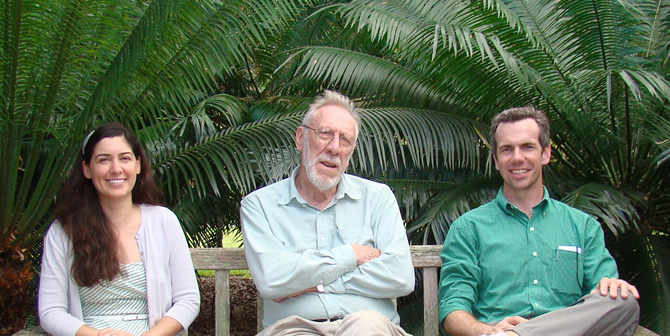
January 6, 2014
Living Plant Conservation Collections:
A Guide for Public Gardens
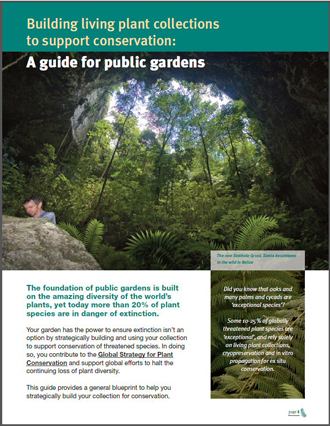 Botanic Gardens Conservation International (BGCI) has published a new guide, Building living plant collections for conservation. The guide features example cases from Montgomery’s work, including genetic evaluation of the Sinkhole Cycad.
Botanic Gardens Conservation International (BGCI) has published a new guide, Building living plant collections for conservation. The guide features example cases from Montgomery’s work, including genetic evaluation of the Sinkhole Cycad.
This guide is designed to provide a general blueprint to help strategically develop conservation collections. Many endangered plants are considered exceptional species, which do not store well in seedbanks, and thus must rely on living collections for conservation. Quoting from the guide:
Your garden has the power to ensure extinction isn’t an option by strategically building and using your collection to support conservation of threatened species. In doing so, you contribute to the Global Strategy for Plant Conservation and support global efforts to halt the continuing loss of plant diversity.
The guide is the result of a recently completed project funded by the Institute of Museum and Library Services, involving MBC, BGCI, and USDA’s Chapman Field.
The guide can be downloaded free from BGCI’s website. For more information on this project and additional resources, please see Montgomery’s Collections Genetics page.
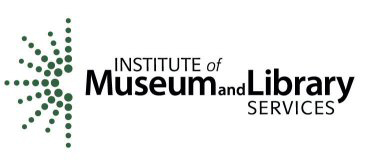
January, 2014
Service Learning in Colleges and Universities:
A new article in Public Garden
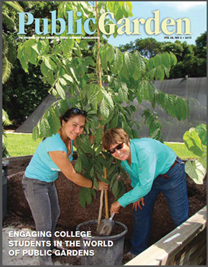 The latest issue of Public Garden magazine, the journal of the American Public Gardens Association (APGA), highlights college students in public gardens. Montgomery Botanical Center's Nursery Curator, Vickie Murphy, and Miami Dade College Service Learner, Evelyn Hoyos, made the cover!
The latest issue of Public Garden magazine, the journal of the American Public Gardens Association (APGA), highlights college students in public gardens. Montgomery Botanical Center's Nursery Curator, Vickie Murphy, and Miami Dade College Service Learner, Evelyn Hoyos, made the cover!
In the article, written by Tracy Magellan, three different Service Learning programs are compared: 1) Miami Dade College/Montgomery Botanical Center, 2) The Sandhills Community College/Sandhills Horticultural Gardens, and 3) Humber College Institute of Technology/Humber Arboretum.
At Montgomery we appreciate the hard work and dedication of the Miami Dade students. They have been a reliable group of students with a great passion for learning.
We have had a combination of students deciding on their majors and students who have already chosen horticulture as their major of interest. Both groups of students have been interested in learning about our rare plants and the special requirements to care for them.
Service Learning programs are good for students and gardens!
January, 2014
Special issue of Botanical Review:
Genetics and Plant Conservation in Latin America
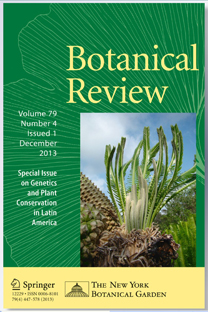 An exciting new issue of Botanical Review features work by Montgomery! The collection of papers here are the proceedings of a symposium on Genetics and Plant Conservation in Latin America, which was chaired by Angelica Cibrian Jaramillo, of Langebio, Mexico.
An exciting new issue of Botanical Review features work by Montgomery! The collection of papers here are the proceedings of a symposium on Genetics and Plant Conservation in Latin America, which was chaired by Angelica Cibrian Jaramillo, of Langebio, Mexico.
Among the in-depth reviews in this issue is a paper on the conservation value of botanic garden plant collections, led by Dr. Cibrian Jaramillo and Patrick Griffith.
Angelica was a featured speaker at MBC’s 50th anniversary gathering in 2009. Her discussion with Patrick Griffith and Javier Francisco-Ortega led to the original idea for this symposium. Quoting from the introduction to the issue:
Over the course of that event, discussion among ACJ, JFO, MPG, and DW Stevenson centered on organizing the symposium documented here. These discussions were informed by collaborative projects built in partnership with colleagues in Latin America and the Caribbean. Perhaps reflecting the garden setting where our discussion began, the last paper included here focuses on botanic garden plant collections, a critical and often overlooked component of plant conservation.
The issue features Microcycas calocoma on the cover, as this plant exemplifies both a species of conservation concern in Latin America, and a botanic garden collection of great conservation value.
January 1, 2014
New videos about Montgomery:
Collections, Research, and Education
Three new videos are now online at MontgomeryTV. Thanks to the dedicated work of James Clugston, Kelly Botanical Research Fellow, you can now see:
• A video highlighting the importance of plant collections at MBC,
• Some highlights of research using the collection, and
• a look at how the collection supports education.
Communicating the vital importance of these living collections was one of James’ goals in making these films—Please take a look!



